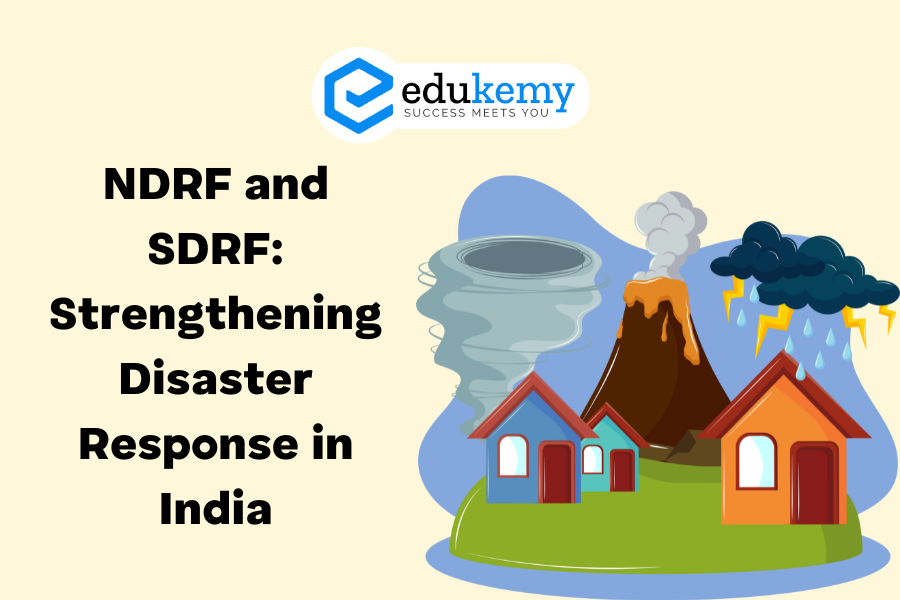
The State Disaster Response Fund (SDRF) and National Disaster Response Fund (NDRF) were established by the Disaster Management Act, 2005, with the primary objective of mitigating hardships arising from natural calamities, including drought. These funds play a crucial role in facilitating timely and effective disaster response efforts.
- State Disaster Response Fund (SDRF):
- SDRF is created to ensure the availability of funds at the state level for immediate relief measures in the event of a disaster.
- Under the Disaster Management Act, all states contribute 10% to the SDRF, with the remaining 90% contributed by the Union Government.
- This allocation is in accordance with the recommendations of the 14th Finance Commission during 2018-19 and 2019-20.
- National Disaster Response Fund (NDRF):
- NDRF operates alongside SDRF and provides additional financial assistance for natural calamities of severe nature.
- The primary purpose of NDRF is to supplement the efforts of state governments by offering financial assistance and logistic support during major disasters.
- Financial Contribution:
- States contribute 10% to the SDRF, demonstrating a shared responsibility for disaster response.
- The Union Government contributes the remaining 90% to SDRF, ensuring that states have the necessary financial resources for immediate relief.
- 14th Finance Commission:
- The allocation and distribution of funds between states and the Union Government are guided by the recommendations of the 14th Finance Commission.
- Additional Assistance:
- NDRF comes into play when disasters of severe nature exhaust the resources available through SDRF.
- It provides supplementary financial assistance to states to address the impact of major disasters and support recovery efforts.
- Logistic Support:
- In addition to financial assistance, NDRF also extends logistic support to state governments during significant natural calamities.
- This includes the mobilization of resources, personnel, and equipment to enhance the effectiveness of disaster response operations.
In summary, the collaborative efforts of SDRF and NDRF, supported by both state and central governments, underscore the commitment to strengthening disaster response capabilities in India. These funds not only ensure quick and efficient relief measures at the state level but also provide crucial additional support when faced with severe and catastrophic natural calamities.
Contents
- 1 FAQs
- 1.1 Q: What is the NDRF and SDRF in India?
- 1.2 Q: How are NDRF and SDRF structured for effective disaster response?
- 1.3 Q: What is the role of NDRF and SDRF during disasters?
- 1.4 Q: How does NDRF and SDRF contribute to disaster risk reduction and management?
- 1.5 Q: What are the challenges faced by NDRF and SDRF in strengthening disaster response in India?
- 2 In case you still have your doubts, contact us on 9811333901.
FAQs
Q: What is the NDRF and SDRF in India?
The National Disaster Response Force (NDRF) is a specialized force established by the Government of India to respond to natural and man-made disasters. It operates under the Ministry of Home Affairs. The State Disaster Response Force (SDRF), on the other hand, is set up at the state level to complement the efforts of the NDRF during disasters.
Q: How are NDRF and SDRF structured for effective disaster response?
The NDRF is organized into specialized battalions comprising personnel trained in various aspects of disaster response such as search and rescue, medical aid, and disaster management. Similarly, each state in India has its own SDRF, which is tailored to the specific needs and challenges of that state. Both forces undergo regular training and drills to ensure preparedness.
Q: What is the role of NDRF and SDRF during disasters?
The primary role of the NDRF is to undertake quick, effective, and specialized response to any disaster situation. This includes search and rescue operations, medical assistance, evacuation, and providing immediate relief to affected areas. SDRF, on the other hand, works in coordination with the NDRF to provide a rapid and localized response to disasters within the respective states.
Q: How does NDRF and SDRF contribute to disaster risk reduction and management?
Both NDRF and SDRF play a crucial role in disaster risk reduction and management by not only responding to disasters but also by conducting awareness campaigns, training programs, and mock drills to enhance preparedness at the community level. They work closely with other stakeholders such as local authorities, NGOs, and international agencies to build resilience and mitigate the impact of disasters.
Q: What are the challenges faced by NDRF and SDRF in strengthening disaster response in India?
Some challenges include the vast geographical spread of India, varying levels of infrastructure and resources across states, coordination issues between different agencies involved in disaster response, and the increasing frequency and intensity of disasters due to climate change. Addressing these challenges requires continuous investment in training, technology, and infrastructure, as well as effective coordination and collaboration among all stakeholders involved in disaster management.
In case you still have your doubts, contact us on 9811333901.
For UPSC Prelims Resources, Click here
For Daily Updates and Study Material:
Join our Telegram Channel – Edukemy for IAS
- 1. Learn through Videos – here
- 2. Be Exam Ready by Practicing Daily MCQs – here
- 3. Daily Newsletter – Get all your Current Affairs Covered – here
- 4. Mains Answer Writing Practice – here

